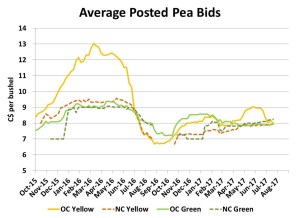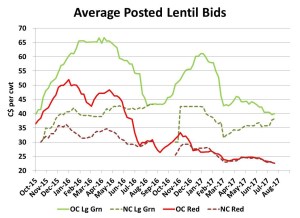Shifting from Old-Crop to New-Crop
The middle of summer can be one of the most confusing times of the year for marketers. Seasonal price tendencies for most crops tend to be at their lows. The conditions of the upcoming crop are being monitored, usually with a fair amount of debate. Farmers are trying to figure out what to do with old-crop supplies and how much new-crop pricing to do. And overseas buyers are sorting out how much coverage they’ll need and how to approach booking for the next few months.
Every year, it seems declining prices through the summer tend to make farmers nervous. Are prices weaker simply because of the normal seasonal patterns or are markets really shifting lower? As we’ve shown in previous reports, both yellow and green pea prices tend to start sliding in late May and bottom out in late August or early September when selling pressure is the heaviest. It’s a similar pattern for lentils, although green lentil prices start to rebound fairly quickly by mid-August while red lentils tend to remain under pressure until later in the marketing year.
Declining prices shouldn’t be ignored, but because this is normal behaviour at this time of year, they shouldn’t trigger panic selling either. More important are the supply outlooks for the upcoming marketing year.
With the next harvest approaching, this is also the time of year when supplies shift from ample to scarce or vice versa. In the first case, old-crop bids will be subdued and new-crop a little higher, while the opposite means high old-crop bids and (sometimes), a sharp drop to new-crop levels. Eventually though, both sets of prices start converging somewhere in the middle. This year, there’s a bit of a mixed bag as the market shifts gears.
For peas, the supply situation has been relatively well-balanced for both yellows and greens. The result is that there’s been relatively little price movement for a while, with old-crop and new-crop bids already in alignment.

In late spring, there had been a flurry of yellow pea purchases which pushed bids higher but overseas buyers are now sitting on comfortable supplies and can wait for the 2017 crop. Whether the upcoming crop is large enough to meet their demand is still open to debate but for now, they feel they can get by with smaller new-crop bookings. Generally though, it’s a sign of underlying support that prices haven’t dropped off more, avoiding most of the normal seasonal weakness.
The situation for lentils is a little different. For greens, supplies have been extremely tight through most of 2016/17 and that pushed old-crop bids up to some very high levels. As the 2017 crop approaches though, buyers are remaining hand-to-mouth as they anticipate fresh supplies. Those higher prices supported green lentil plantings this spring which kept new-crop bids subdued, at least until recently. The latest crop concerns though have the market more on edge, especially since buyers have very low inventories. That’s causing old-crop and new-crop bids to both move toward the middle.

For red lentils, global supplies had been more comfortable (than greens) for the entire 2016/17 season and that’s kept bids on the defensive. Overseas buyers are still sitting on sizable inventories, which means they haven’t pursued new-crop booking aggressively and bids for fall delivery are remaining soft.
Of course, these price environments are based on what we know now, and conditions will undoubtedly change as North American crops are harvested and monsoons affect Indian crop potential. For now though, the quiet price environment for peas and red lentils suggest price recoveries will be more gradual and slower to arrive.
Source : Albertapulse